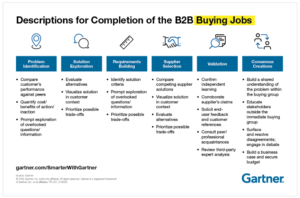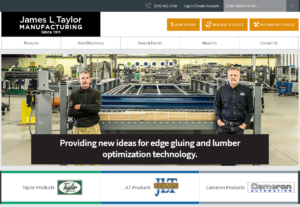The manufacturing buying cycle
B2B buyers are increasingly using more channels throughout their decision-making process when shopping for a new product or service. This is lengthening an already long buying cycle, with B2B sales to new customers taking at least 4 months to close (often longer).
The buying journey is also highly complex. Recently, global research firm Gartner revealed six different types of buying activities (e.g., jobs) required for every purchase. The Gartner buying model looks like this:

The consequence of so many buying activities is that B2B buyers end up with a surplus of information which can delay and confuse purchase decisions. A Gartner survey revealed that nearly 90% of B2B customers who responded reported that they were able to find high-quality information on a particular product or service. This was often overwhelming, leading to customers spending 15% of the buying cycle reviewing and comparing conflicting information.
Luckily, manufacturing marketers have a powerful tool at their disposal to help clarify their message with today’s over-informed buyers—the company website. Buyers of industrial products use both sales reps and the manufacturer’s website throughout the buying process.
If your web content isn’t fully aligned with your sales team’s content (and vice versa), you risk frustrating and confusing potential customers.
Keep your website strategy focused on simplicity
The most impactful way to make complex information easy to digest is to keep your website’s user experience (UX) as simple and straightforward as possible.
Salesforce recently put this strategy into action for Pardot.com, the website for Pardot. Pardot is a lead nurturing platform which contains a suite of tools that cover a variety of tasks involved with nurturing a lead from first contact through closing. Salesforce streamlined Pardot.com, reducing the navigation to five categories that answered critical questions. The result was that they generated 15% more conversions and 29% more leads to their pipeline.
Keeping content simple starts with understanding what kind of information customers are looking for and streamlining site navigation to address only those key issues.
Figuring this out should involve multiple stakeholders within a given company, but marketing and sales should definitely factor into this process, as should customer feedback.
This is the approach we took when we redesigned James L. Taylor Manufacturing’s (JLTM) website. One of our key goals with the redesign was to simplify the home page experience while incorporating JLTM’s three sub-brands without overwhelming users. We did this by creating simplified navigation and incorporating the three brands at the bottom of the home page layout.
Keep in mind that while B2B buyers are looking for answers to very specific questions, their preference is to get these answers without speaking with a salesperson. At least, at first.
Millennial buyers, in particular, tend to be skeptical of sales reps and prefer data-backed evidence when researching a new product or service. Putting this information front and center on your website using intuitive, but spare, navigation, will ensure your site visitors have a positive experience when visiting your website.
Keep your story consistent
Information consistency matters in the B2B space since buyers get information from multiple sources which may include the manufacturer’s website, social media, sales reps, and peers.
A recent Gartner study reported that only 25% of B2B customers felt the information they receive from multiple channels was highly consistent. But addressing inconsistency and ensuring information aligns at all channels pays off. The Gartner study revealed that prospects who report consistency with vendor messaging and content are more than 4x likely to make a purchase.
When creating your website UX and content strategy, make sure that it aligns with all touchpoints that a prospect will meet, particularly the sales team.
A content marketing strategy can help ensure content consistency, as can a content marketing platform which enables suppliers to aggregate and streamline their marketing content from one central location.
Speed counts
We focused on making the JLTM website more modern and that means ensuring that it was mobile-friendly.
Mobile-friendly websites are fast loading and easy to navigate. This is important for a number of reasons, not the least of which is that Google began incorporating mobile page speed into their algorithm last year.
In 2018, Google reported that more than half of mobile visitors leave a page that takes longer than three seconds to load, but the average mobile landing page took about fifteen seconds to load, so there’s clearly room for improvement. Here are a few ways to do that.
- Manufacturing marketers need to make sure that the content located above the fold of a page takes no longer than 5 seconds to load. Google found that as page load time goes from 1 second to 10 seconds, mobile site bounce rate increases by over 123%. Conversion rate drops precipitously with slower loading pages too, thus it’s incredibly important to ensure your website is as fast as it can be.
- Test your mobile page speed using Google’s free Test My Site tool.
- Make sure you’re using a mobile-friendly web development platform such as WordPress or Drupal. These platforms have built-in mobile functionality such as Responsive Web Design which automatically renders pages based on a variety of user devices and screen sizes. The tool generates a report that provides recommendations for improving page speed on mobile devices.
Collaboration between marketing and sales is key
As B2B buyer behavior changes, so too do the roles of marketing and sales teams. These teams can no longer operate in a siloed environment and expect to deliver a consistent message. Gartner posits that sales is just another channel to reach prospects, but it’s no longer the only channel.
“Buyers are channel agnostic,” Gartner reports. “They have no clear preference for digital or in-person and just care about finding information that helps them advance.”
Manufacturing organizations must simplify the delivery of this information by aggregating information and ensuring that it is consistent across multiple touchpoints. The starting point for this kind of approach is almost always with the manufacturer’s website. By focusing the website design on delivering high quality information in a straightforward, user-friendly way and updating it so that it’s modern, mobile-friendly, and presents a clear path for visitors, suppliers can get the most out of this powerful marketing tool.


